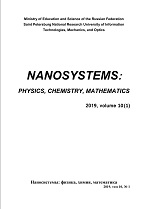|
This article is cited in 8 scientific papers (total in 8 papers)
CHEMISTRY AND MATERIAL SCIENCE
Low coercivity microwave ceramics based on LiZnMn ferrite synthesized via glycine-nitrate combustion
K. D. Martinsonab, S. S. Kozyritskayaa, I. B. Panteleeva, V. I. Popkovacb
a Saint Petersburg State Institute of Technology (Technical University), Moskovskyi pr. 26,
Saint Petersburg, 190013, Russia
b Ioffe Institute, Politechnicheskaya 26, Saint Petersburg, 194021, Russia
c Saint Petersburg University, 26 Universitetskii prospect, Saint Petersburg, 198504, Russia
Abstract:
Soft magnetic LiZnMn ferrite with low coercivity obtained via glycine-nitrate combustion was estimated in this work. According to SEM, the synthesized ceramics have a grain size ranging from 1.5 to 8 $\mu$m and the EDX, AAS and XRD data show that the obtained samples correspond to Li$_{0.45}$Zn$_{0.05}$Mn$_{0.06}$Fe$_{2.43}$O$_4$ structure. The hysteresis loops of LiZnMn ferrite ceramics provide evidence for the magnetically soft nature of the obtained materials. Basic magnetic characteristics, including remanent magnetization, saturation magnetization, and coercive force was also described. For a sample sintered at 1000$^\circ$ C, the values of saturation magnetization (4$\pi$M$_s$), residual magnetization (B$_r$) and coercive force (H$_c$) were 2644 G, 2139 G and 6.4 Oe, respectively, whereas the sample obtained at 1070$^\circ$ C shows large values of saturation magnetization (3240 G) and residual magnetization (2459 G) and the coercive force is approximately half (3.4 Oe). Analysis of the influence of thermal treatment provided the possibility to determine necessary conditions for obtaining microwave ceramics based on LiZnMn ferrite via solution combustion method. Grain size distribution was examined to determine their influence on the properties of obtained ceramics.
Keywords:
microwave ceramics, spinel ferrites, solution combustion synthesis, soft magnetics.
Received: 18.06.2019
Revised: 20.06.2019
Citation:
K. D. Martinson, S. S. Kozyritskaya, I. B. Panteleev, V. I. Popkov, “Low coercivity microwave ceramics based on LiZnMn ferrite synthesized via glycine-nitrate combustion”, Nanosystems: Physics, Chemistry, Mathematics, 10:3 (2019), 313–317
Linking options:
https://www.mathnet.ru/eng/nano444 https://www.mathnet.ru/eng/nano/v10/i3/p313
|

| Statistics & downloads: |
| Abstract page: | 143 | | Full-text PDF : | 52 |
|




 Contact us:
Contact us: Terms of Use
Terms of Use
 Registration to the website
Registration to the website Logotypes
Logotypes








 Citation in format
Citation in format 
